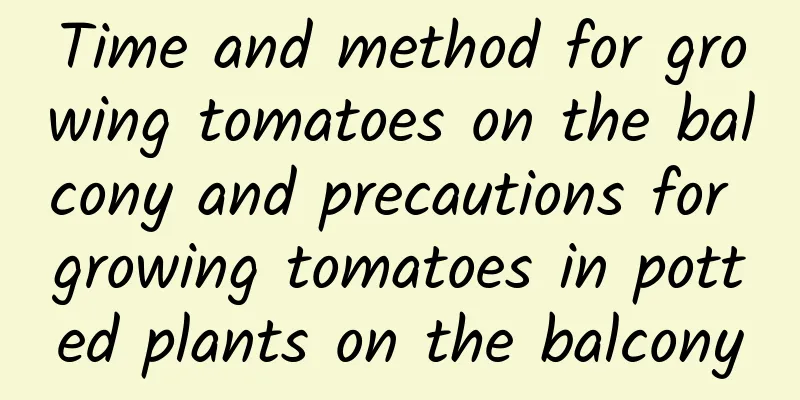Time and method for growing tomatoes on the balcony and precautions for growing tomatoes in potted plants on the balcony

|
It is good to grow tomatoes on the balcony. Some balconies have sufficient sunlight, which is conducive to tomatoes absorbing light and converting nutrients into organic matter, thereby producing high-quality tomatoes. Paying attention to fertilizer and water management can increase the yield of balcony tomatoes. Planting is relatively simple. Steps to grow tomatoes on the balcony1. Soil: Tomatoes need deep, well-drained, breathable, fertile and loose soil. The culture soil can be mixed with humus and garden soil in a ratio of 1:1. The culture soil prepared in this way can retain moisture but is not easy to accumulate water. 2. Seeds: Dwarf varieties of potted tomatoes are better, such as Nonghong No. 1. Soak the seeds in 50℃ warm water for twelve hours before sowing. When the time is up, pick them up and sow them evenly in the seedling pot. Then lightly cover them with a layer of culture soil and keep the culture soil moist. The seeds will germinate in about a week. When the seedlings grow 4 leaves, they can be transplanted. 3. Planting: The best tomato planting pot is a deeper clay pot. Fill it with culture mud, dig up the seedlings together with the soil, and plant them in the clay pot. Plant one plant in one pot. After planting, water the pot to help it take root. Key points for growing tomatoes on the balconyWhen growing tomatoes on the balcony, they should be placed in an area with plenty of sunlight to allow them to photosynthesize. This will allow them to accumulate more sugar and improve the quality of the fruit. However, the light intensity is very high at noon in summer, so shade measures need to be taken. No fertilizer is needed during the growing period of tomatoes. Keep the soil in the planting pot moist and water it about once every 3-5 days. Do not water it too frequently, otherwise the roots will rot. During the fruiting period, you can spray 0.3% potassium dihydrogen phosphate on the leaves once a week. If the plant lacks fertilizer, you can apply compound fertilizer and apply thin fertilizer frequently. |
Recommend
Planting methods and precautions for longevity tree potted plants
The longevity tree is one of the most popular flo...
Dandelion soaked water benefits
effect Clearing away heat and detoxifying Dandeli...
Can ginger lotus bloom in winter?
1. No flowering The flowering period of ginger lo...
When is the best time to repot the Jade Plant? What is the best time and method to repot?
Time to repot Jade Plant The Jade Plant grows rel...
How to water jasmine? Watering the flowers this way will make them more fragrant!
Growth environment requirements The air humidity ...
How to propagate cyclamen
Select the parent Healthy plants should be select...
How to make your own lucky bamboo nutrient solution
1. How to make nutrient solution yourself The fir...
How to propagate and transplant trumpet creeper
1. How to propagate trumpet creeper 1. Seed propa...
What are the methods of propagating Jade Dew?
Division It can be combined with repotting, or th...
Identify vegetables by looking at flowers. If you can recognize 5 types, you are awesome!
The game begins. See how many you know. First, lo...
How to propagate red sorrel and what to pay attention to
How to propagate Oxalis serrata The reproduction ...
What diseases does the fungicide chlorothalonil treat?
Thiophanate-methyl is a broad-spectrum fungicide ...
The best time to plant osmanthus trees
The sweet-scented osmanthus tree prefers warm cli...
Where is it suitable to grow apricots?
Apricot Growing Area Apricot trees do not have hi...
Is hibiscus edible?
Hibiscus Nutrition Hibiscus flowers are sweet and...









